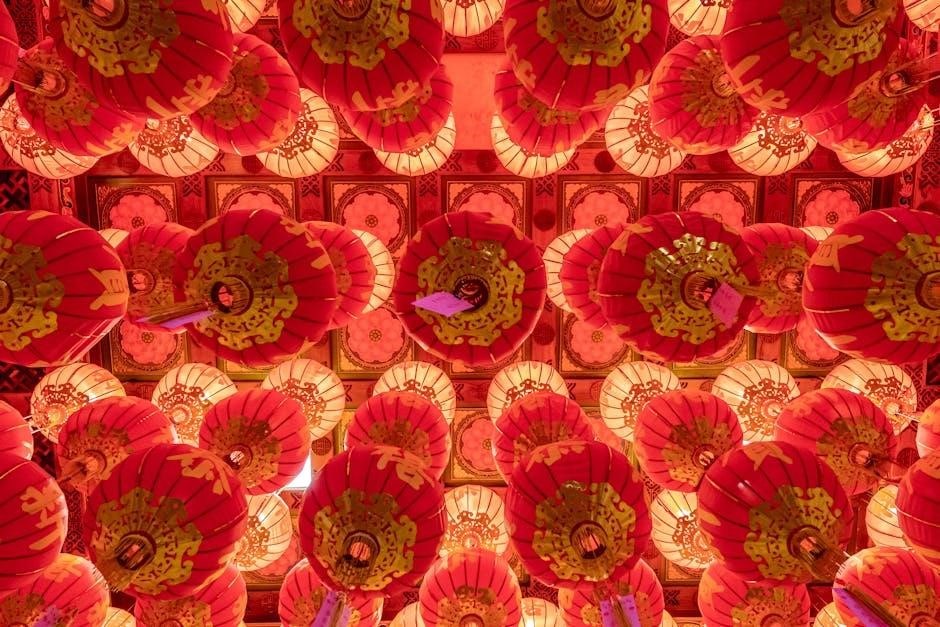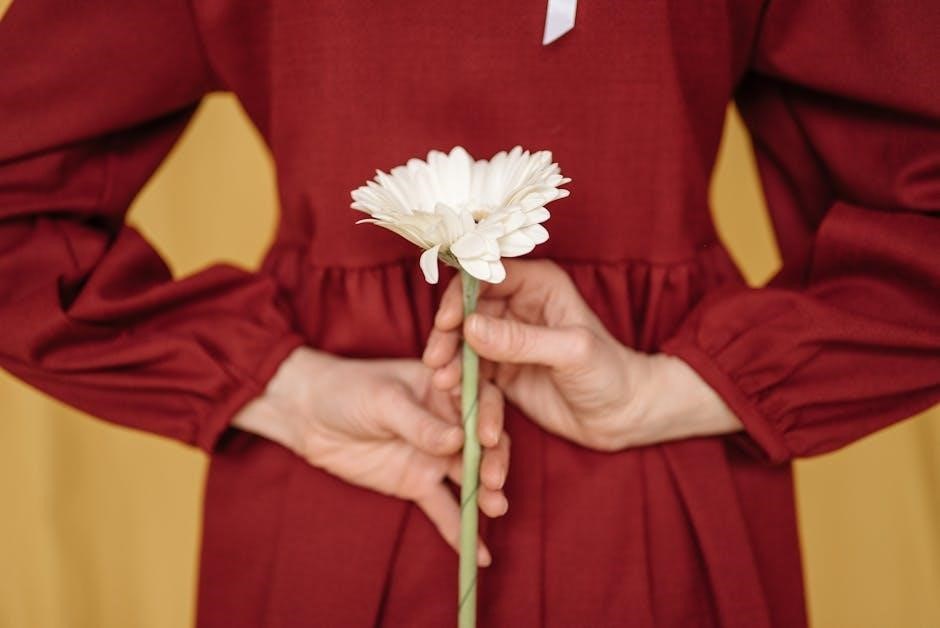Adinkra symbols, originating from West Africa, are visual representations of proverbs, philosophies, and cultural values․ They convey wisdom and beliefs through intricate designs, rich in historical significance․

Understanding Adinkra Symbols
Adinkra symbols are visual representations of proverbs, concepts, and philosophies rooted in Akan culture․ Originating from the Asante people of Ghana, these symbols are more than mere designs; they carry deep meanings tied to wisdom, morality, and cultural values․ Each symbol is associated with a specific proverb or saying, making them a gateway to understanding Akan philosophy․ They are often used to convey complex ideas in a simple, yet powerful, visual form․ Beyond their aesthetic appeal, Adinkra symbols serve as a bridge between the past and present, preserving history and cultural identity․ Their meanings are diverse, ranging from leadership and resilience to nature and spirituality, offering insights into the Akan worldview․
Cultural Significance and Historical Background
Adinkra symbols hold profound cultural and historical significance, rooted in the traditions of the Akan people of Ghana and Côte d’Ivoire․ These symbols were initially used in royal and ceremonial contexts, conveying messages of wisdom, leadership, and community values․ Historically, they were printed on cloth, known as Adinkra cloth, worn by chiefs and leaders to symbolize status and authority․ The symbols also played a role in oral traditions, serving as visual aids to teach moral lessons and preserve history․ Their creation is tied to the legend of King Nan Kofi Adinkra of Gyaman, who introduced the art to the Asante people․ Over time, Adinkra symbols have evolved, becoming a celebrated part of African heritage and identity, both locally and within the diaspora․
Origins and History of Adinkra Symbols
Adinkra symbols originated from the Gyaman kingdom, introduced by King Nan Kofi Adinkra․ The name “Adinkra” means “farewell” in the Akan language, symbolizing wisdom and heritage․
The Name “Adinkra” and Its Meaning
The term “Adinkra” derives from the Akan language, specifically meaning “farewell” or “goodbye․” It is rooted in the legend of King Nan Kofi Adinkra of Gyaman, who lost a battle to the Asante people․ The name symbolizes the end of an era and the beginning of a new cultural chapter․ Adinkra represents wisdom, resilience, and the enduring legacy of Akan philosophy․ Its meaning extends beyond language, embodying the rich cultural heritage and symbolic expressions of the Akan people, making it a cornerstone of their identity and traditions․ The name itself is a testament to the historical journey and cultural significance of these iconic symbols․
Historical Journey from Gyaman to Asante
Adinkra symbols trace their origins to the Gyaman kingdom, where King Nan Kofi Adinkra ruled․ After his defeat by the Asante people, the symbols were adopted and integrated into Asante culture․ This historical migration marked a significant cultural exchange, preserving the symbols’ philosophical depth while infusing them with new meanings․ The journey from Gyaman to Asante highlights the resilience and adaptability of Akan traditions, ensuring the symbols’ enduring relevance․ This transition not only enriched Asante heritage but also solidified Adinkra as a unifying element of Akan identity, bridging past and present․

Cultural Significance of Adinkra Symbols
Adinkra symbols hold profound cultural value, representing Akan proverbs, philosophies, and traditions․ They embody wisdom, history, and identity, serving as a bridge between heritage and contemporary life globally․
Adinkra as Visual Representations of Proverbs and Philosophies
Adinkra symbols are intricate visual expressions of Akan proverbs and philosophies, conveying deep truths about life, nature, and human behavior․ Each symbol encapsulates a specific moral lesson or wisdom, often linked to oral traditions of the Akan people․ For instance, the Ananse Ntontan symbol, depicting a spider’s web, signifies wisdom, creativity, and strategic thinking․ Similarly, Akoko Nan, the hen’s leg, represents mercy and nurturing․ These symbols serve as a bridge between the spoken word and visual art, allowing complex ideas to be understood universally․ Their design and meaning have been preserved through generations, making them a vital part of African cultural heritage and global philosophical expression․
Role in Oral Traditions, Architecture, and Art
Adinkra symbols play a vital role in oral traditions, serving as visual aids to convey stories, teachings, and cultural values․ They are integrated into architecture, adorning walls, palaces, and sacred spaces, symbolizing communal identity and wisdom․ In art, these symbols are used in pottery, metalwork, and cloth design, creating a bridge between tradition and creativity․ Their incorporation into various art forms highlights their enduring relevance and cultural significance․ By blending philosophy with aesthetics, Adinkra symbols continue to inspire artistic expression while preserving the rich heritage of the Akan people․ Their presence in these domains underscores their importance as both decorative elements and carriers of deep cultural meaning․

Meanings Behind Adinkra Symbols
Adinkra symbols embody profound meanings, reflecting Akan wisdom, proverbs, and philosophies․ Each symbol carries specific interpretations, often tied to nature, human behavior, and moral values, enriching cultural understanding․
Symbolic Meanings and Proverbs
Each Adinkra symbol carries a unique meaning, often tied to Akan proverbs and philosophies․ For instance, the “Ananse Ntontan” (spider’s web) symbolizes wisdom and creativity, while “Sankofa” (bird looking backward) represents the importance of learning from the past․ These symbols encapsulate moral lessons, cultural values, and historical insights, serving as a visual language to convey complex ideas․ They are deeply rooted in Akan wisdom, offering guidance on human behavior, nature, and spirituality․ The symbols are not just decorative but carry profound messages, making them a vital part of Akan heritage and identity․ Their meanings continue to inspire and educate, bridging the gap between tradition and modern life․
Popular Adinkra Symbols and Their Interpretations
Among the most recognized Adinkra symbols is the “Adinkrahene,” symbolizing leadership and charisma, often associated with kingship․ The “Akoko Nan” represents a hen’s leg, embodying mercy and nurturing care, while the “Ananse Ntontan” (spider’s web) signifies wisdom and creativity․ Another popular symbol, “Sankofa,” depicts a bird looking backward, emphasizing the importance of learning from the past․ These symbols are not only aesthetically striking but also carry deep philosophical meanings․ They are widely used in art, fashion, and design, inspiring people globally with their timeless wisdom․ Each symbol tells a story, making them a cherished part of Akan cultural heritage and a source of inspiration for modern applications․
The Process of Creating Adinkra Symbols
Adinkra symbols are traditionally created using calabash stamps carved by skilled artisans․ The process involves stamping intricate designs onto cloth with natural dye, reflecting cultural expertise․
Traditional Methods and Materials
Adinkra symbols are crafted using traditional methods passed down through generations․ Artisans carve intricate designs into calabash gourds, which serve as stamps․ The gourds are carefully selected, dried, and shaped before carving․ Natural materials like tree bark and soot mixed with water create the dye used for stamping․ The cloth, typically cotton, is treated to ensure the dye adheres․ The process is meticulous, requiring patience and skill․ Each symbol is stamped one by one, creating unique patterns with deep cultural significance․ This traditional method ensures the preservation of Adinkra’s cultural heritage and maintains its authenticity in contemporary times․

Contemporary Relevance and Global Influence
Adinkra symbols are increasingly prominent in modern art, fashion, and design, while their adoption by the African diaspora highlights their global influence and enduring cultural significance․
Modern Uses in Art, Fashion, and Design
Adinkra symbols have gained prominence in contemporary art, fashion, and design, inspiring creators worldwide․ Designers incorporate these symbols into textiles, clothing, and accessories, blending tradition with modern aesthetics․ In art, they are used to convey cultural pride and philosophical messages, while in design, they add unique visual storytelling to products․ Digital platforms have further amplified their reach, making them popular in logos, branding, and digital art․ Their universal appeal lies in their ability to connect the past with the present, offering a bridge between African heritage and global trends․ This resurgence highlights their enduring relevance and adaptability in today’s creative industries․
Adoption by the African Diaspora
Adinkra symbols have been embraced by the African diaspora as a powerful way to reconnect with their cultural heritage․ They are widely used in clothing, jewelry, and art to express identity and pride․ The diaspora has adapted these symbols to fit modern contexts, blending them into contemporary designs while preserving their original meanings․ This adoption has helped to keep the legacy of Adinkra alive, fostering a sense of unity and shared history among people of African descent worldwide․ The symbols now serve as a bridge, linking generations to their ancestral roots and promoting cross-cultural understanding and appreciation of African traditions․
Adinkra symbols embody timeless wisdom, cultural richness, and historical depth, continuing to inspire global audiences with their profound meanings and aesthetic beauty․
The Enduring Legacy of Adinkra Symbols
Adinkra symbols, rooted in Akan culture, continue to inspire global audiences with their profound meanings and aesthetic beauty․ Originating from Ghana and Côte d’Ivoire, these symbols encapsulate cultural values, proverbs, and philosophies․ Their survival through centuries, despite colonial influence, highlights their resilience and significance․ Today, Adinkra symbols are celebrated worldwide, featured in art, fashion, and design․ They serve as a bridge between tradition and modernity, symbolizing wisdom, creativity, and community․ Their adoption by the African diaspora has further cemented their legacy as icons of African cultural identity․ Adinkra symbols remain a timeless source of inspiration, connecting generations to their heritage and fostering cross-cultural understanding․
